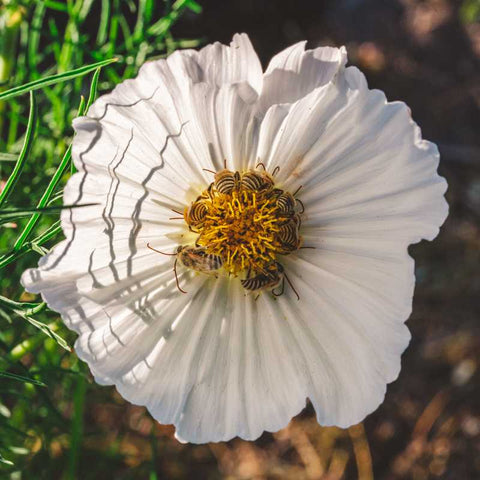Cosmos Cultivation for Flower Farmers
April 05, 2024 8 min read 0 Comments

Today, we will delve into a flower that is a cornerstone of our summer offerings: the cosmos.
What are Cosmos?
Cosmos are happy disk-shaped flowers that come in a range of colors from whites, deep burgundies, a range of pinks, buttery yellows, bold oranges, and soft apricots with a cheery yellow center. There are also different forms and varieties of cosmos, from singles to fluffy doubles to novelty spooned and cupped varieties.
Cosmos have earned their spot in many gardens for their beauty and for providing much-needed nourishment to beneficial insects such as bees and butterflies. Often, as the fall frosts draw near and the bees are ending their seasonal life cycle, we find them cozied up together in the folds of cosmo centers.

Cosmos are an excellent addition to a cut flower operation for their productivity. When we first started growing cut flowers on a mere 2,500 square foot patch, the cosmos saved us time and time again to fill out bouquets despite our minimal growing space.
The Best Cosmos Varieties to Grow
As mentioned, there is an array of cosmos from which to choose. Some make great cut flowers, and some do not. Some can easily be grown from seed, and others cannot. Let’s talk about more popular cosmo cultivars!
Sulphur cosmo (cosmo sulphureus) is sought after for its natural dying abilities. The most popular being Bright Lights. Sulphur cosmos come in warm summer hues like yellow, orange, and red.
Aside from its fabric-dying abilities, it is also popular for garden beds, especially in pollinator gardens. Though beautiful, it is not usually grown as a cut flower due to its shorter vase life compared to other options. It is also the only variety of cosmos that can be grouped into edible flowers.
Chocolate cosmo (cosmos atrosanguineus) is a deep, velvety burgundy variety with an underlying scent reminiscent of chocolate. Don’t let the smell fool you, though; this variety is NOT edible.
This variety differs from the others in that it is commonly grown from a tuber, similar to a dahlia, as a perennial down to growing zone 8. It is also a favorite amongst wedding florists.
Cosmos as cut flowers

The cultivar of cosmos we grow for cut flowers is cosmo bipinnatus, which are commonly known as “lace cosmos.” Cosmo bipinnatus are loved by flower farmers for their long, sturdy stems and array of colors. It adds whimsy and movement to floral designs and bouquets as a light and airy cut flower. When growing for event flowers, we can never have enough whites and muted tones, thankfully there are quite a few to choose from in the cosmo bipinnatus family!
A few of our absolute favorite cosmos currently are:
- Fizzy White, which has become our main go-to white for its incredibly long and prolific stems and its unique tufted center.
- Afternoon White, another white cosmo we can’t get enough of, which reminds me of fluttering white Iceland poppies.
- Apricotta is a single-petaled variety with unique apricot shades that have become increasingly popular for our wedding designs.
Some other Cosmos varieties worth mentioning are:
- Double Click a series with beautifully doubled petals in colors reminiscent of crushed berries: whites, bubblegum pink, rose, and cranberry. A lovely variety, though the flower heads tend to look down due to the weight of the flower heads.
- Cupcakes are a novelty form of cosmo that looks just as its name sounds: like cupcake liners! Beautiful cupped variety is not often seen, but it comes in a variety of pinks and white. Our farmer’s market and CSA members adored these!
- Versailles is a solid single-petaled series that comes in white, pinks, and purples. There are also some interesting single-petaled varieties with spectacular shifting colors.
- Rubenza begins as a deep raspberry-colored flower that fades to an antique rose color, which goes wonderfully for the popular dusty rose color palettes.
- Xsenia begins as a rose-colored flower that fades to an amber color, making it a great variety for fall offerings.
There are many more cosmo bipinnatus varieties to choose from than what I have listed. Take some time to explore the various seed catalogs to find worthwhile varieties for your cut flower farm.
You will probably find that growing cosmos is easier than picking out which ones to grow!
How to Grow Cosmos

When cosmos come into bloom
Cosmos are a warmth-loving plant that is sensitive to frost. They are also photoperiod sensitive, blooming best once daylight hours reach below fourteen hours. Cosmos come into bloom in summer through early fall.
When to start and plant cosmos
Since cosmos are frost sensitive, they shouldn’t be planted out until nighttime lows have stabilized to 40 degrees Fahrenheit and daytime temperatures are hovering around mid-50 degrees Fahrenheit, though they do prefer warmer temperatures. Mid to late spring is ideal for starting cosmos.
Growing cosmos from seed

Cosmo seeds are a skinny brown seed that is a decent size for hand-sowing, which is great since most seeders don’t accommodate the shape of the seed. Cosmos also typically have an outstanding viability rate and are fairly quick growers.
Direct sowing cosmos on the farm
Cosmo seeds have speedy germination, usually about a week from sowing with ideal temperatures. Cosmos grow quickly and can become stunted if the seedlings become too root-bound. Between their fast germination and not loving their roots touched, they are ideal candidates for direct sowing into the growing bed.
We begin direct sowing in mid-spring, once soil temperatures are at least 65 degrees Fahrenheit, ideally in the 70s.
Growing transplants
To get a jump start on our season, we start our first round of cosmos in April. We start them as transplants five to six weeks before wanting to plant them out in their growing beds, usually in May. To accommodate their fast growth and to avoid them getting root-bound, sow seeds into 50-cell trays or in 2” soil blocks. Recently we started using our 72-cell air prune trays to fit more seedlings in our greenhouse without them getting root-bound or crowded.
Sow two seeds per cell and cover lightly with soil. Seedlings can be transplanted out four to six weeks after germination.
Cosmos benefit from having their main stalk “pinched” once the seedling reaches 12- 15 inches tall. This process encourages the plant to branch out and produce more usable stems.
Propagating cosmos from cuttings
Cosmos can be propagated from cuttings, much like marigolds.
To do this, take clean clippers and cut out the center stalk, leaving two to three sets of true leaves. Take the cuttings and remove all but the top leaves. If there is a bud forming, remove that, too, by pinching it out. Dip the cuttings in coconut water or rooting hormone and place them into a prepared 50-cell planting tray with your chosen propagation substrate that is damp, like a wrung-out sponge.
Keep cuttings hydrated by misting leaves with water and placing a humidity dome over the seedlings. Place the cuttings onto a heating mat set to 70 degrees Fahrenheit, out of direct sunlight. Keep cuttings hydrated but not soggy. Cosmo cuttings should begin rooting in three to four weeks.
Succession planting cosmos
Cosmos are heavy producers but do tend to get tired after a few weeks of pushing piles of stems out, often succumbing to disease or pest pressure. Succession sowing helps to keep healthy, productive plants on the farm from summer through the first killing frost.
Cosmos can be succession sown in three to four-week intervals from spring through mid-summer. For our climate, our last succession is a direct sowing in June since we usually start dipping into freezing temperatures in late September to early October. A succession in July through early August may be worth it in areas with later fall frosts.

Planting and maintenance of Cosmos on the Flower Farm
Cosmos require full sun; choose a location with a minimum of eight hours of sun per day. The plants prefer soil with lower nitrogen amounts, otherwise, you may get lush plants with minimal flowers.
We transplant our first succession of cosmos under a micro tunnel of frost cloth to better protect the plants from late spring frosts. At planting, we also direct sow our next succession of cosmos.
Cosmos like elbow room, at 7-12 inch spacing to better produce strong, sturdy stems. In our arid climate, we plant ours 7x7 inches and haven’t seen a decreased quality of stems.
Cosmos can get quite tall. Horizontal or corral trellising is recommended, especially in windy areas, to prevent the plant toppling over.
Pests and diseases that affect cosmos
Cosmos are prone to powdery mildew. If you are in a more humid climate where plants battle powdery mildew, give cosmos plants more room to encourage airflow to help mediate disease. This is where 12 inch spacing comes in. Cosmos are also prone to bacterial wilt, which will cause the plant to suddenly turn brown, wilt, and die. To help prevent disease, be sure not to oversaturate plants and do a proper crop rotation each year.
Bees love cosmos, but unfortunately, aphids, leafhoppers, and Japanese beetles also find them desirable. We typically see pest pressure on older plants later in the season. Ripping out the plants at the first sign helps, along with your chosen pest management protocols.
Harvesting Cosmos

Cosmos are considered a short-lived cut flower and do poorly as a stored flower. This makes them a better offering for the local market as shipped flowers would not survive in the vase.
The key to maximum vase life for cosmos is cutting at the optimal stage. Usually, the stems of cosmos have multiple flower heads, we aim to harvest the stem when one flower head is open, but the centers are still fresh and yellow. Harvesting stems when the buds are swollen has provided us some wiggle room in terms of storing flowers longer. Harvesting more open flowers creates usable stems for event work or to provide presentation in a mixed bouquet.
Cut cosmos tend to wilt in the heat of the day, so harvesting early in the morning before the pollinators get busy is best. Not only does this keep the cut flowers happy, but you won’t be battling buzzing bees while trying to harvest. Plus, we don’t want the flowers pollinated, if possible. In their peak production, you may also find yourself harvesting in the evenings.
To harvest, cut the stem down the length of your arm, about 12-20 inches. Don’t be shy; cosmos do best when cut hard to produce even more long, beautiful stems. We place ten stems per bunch. We place the cut cosmos directly in a clean bucket of water treated with a preservative tablet that then goes into the cooler set to 37℉ - 40℉ to hydrate for a minimum of five hours. Cosmos can be stored in the cooler for three to four days.
The average vase life for cosmos is five to seven days.
Using cosmos as a design component
When we are missing butterfly ranunculus, the cosmos swoop in to save the day! Cosmos are our affordable summer version of butterfly ranunculus with its spray of bouncing flower heads atop their slender stem.
Cosmos are a great supporting flower to accompany larger, luxurious flowers such as dahlias or sunflowers. In the right color, cosmos are beautiful in bud vases sitting at a wedding reception table, floating in an arbor design or shallow compote vase.
Cosmos seed prices are relatively inexpensive, especially considering the plant is a prolific producer, making it a great variety for u-pick operations, farmer’s markets or CSA bouquets.
Why we love cosmos?
Cosmos have been a vital flower for our flower farming business. Starting with being tucked into mixed bouquets for farmer’s markets, they have continued to be important for our wedding work and wholesale to our local florist friends. They add a lovely movement to designs and give that “scooped from the garden” appeal that is highly sought after. A recognizable flower that is also not easily attained unless you are growing it for yourself, you will not see them sitting in the supermarket anytime soon, making them all the more special.

Subscribe
Sign up to get the latest on sales, new releases and more …
